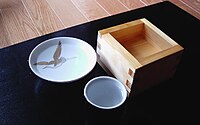
Photo from wikipedia
Abstract Among phenolic compounds, Agave americana L. extract contained puerarin (38.4%) and p-coumaric acid (12.29%) (pCa). From the Lineweaver–Burk plots, pCa and puerarin demonstrated a competitive and a non competitive… Click to show full abstract
Abstract Among phenolic compounds, Agave americana L. extract contained puerarin (38.4%) and p-coumaric acid (12.29%) (pCa). From the Lineweaver–Burk plots, pCa and puerarin demonstrated a competitive and a non competitive inhibitions towards human α-amylase activity, respectively. PCa exhibited a higher human inhibitory activity with an IC50 of 98.8 μM which was about 2.3 times than acarbose. Puerarin (IC50 = 3.87 μM) and pCa (IC50 = 10.16 μM) also showed an excellent inhibition for Aspergillus oryzae S2 α-amylase activity. The inhibitions of the described biocatalysts compounds towards both amylases were significantly decreased when they were pre-incubated with starch. The binding modes of these compounds were evaluated in silico. The binding efficiency order of these molecules in terms of polar contact numbers for both enzymes was in agreement with the in vitro studies. These findings provided a rational reason to establish the isolated compounds capability as therapeutic target for hyperglycaemia modulation and antifungal therapy.
Journal Title: Natural Product Research
Year Published: 2019
Link to full text (if available)
Share on Social Media: Sign Up to like & get
recommendations!